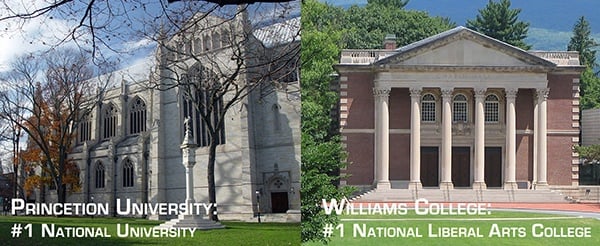
US News is probably the most popular source out there for college rankings. While US News rankings of colleges purport to be highly accurate, they can be misleading in certain important respects. If you make decisions based purely on the US News college rankings, you might end up being miserable.
In this article, I'll go over why you shouldn't make judgments about colleges solely based on their rankings in US News.
What Types of Rankings Does US News Provide?
US News divides its college rankings into four different categories. The categories are based on the 2018 Basic Classification system developed by the Carnegie Foundation for the Advancement of Teaching. This system has 12 categories of schools, but US News condenses them into four. These include:
National Universities
These are schools that offer master's and doctoral degrees along with a full range of undergraduate majors. This category contains "research universities", where there is a strong emphasis on research and government subsidies are often provided for research endeavors. There are 439 universities that fall into this category.
National Liberal Arts Colleges
These are colleges that emphasize undergraduate education and give out at least half of their degrees in liberal arts disciplines including languages and literature, biology and life sciences, philosophy, cultural studies, and psychology. There are 211 of these colleges.
Regional Universities
These colleges are similar to National Universities in that they offer both a full range of undergraduate majors and master's programs. However, they offer limited or nonexistent doctoral programs. Regional Universities are split into four geographic categories: North, South, Midwest, and West.
Regional Colleges
These are colleges that focus on undergraduate education but have less of a liberal arts emphasis (award less than half of their degrees in liberal arts disciplines). Like the Regional Universities, these schools are organized by geography, with four sub-categories: North, South, Midwest, and West.
It's important to consider these categories because they should affect how you view the rankings. US News specifically states that you shouldn't compare the rankings of two colleges across two different categories; the schools are so different that making a direct comparison is not logical. You can compare the actual statistics (such as test scores, student retention, and average class size), but in terms of rank itself, a school that's ranked 40th in the National Universities category is not objectively "worse" than a school that's ranked 32nd in the National Liberal Arts Colleges category.
 Very liberal art
Very liberal art
How Does US News Rank Colleges?
There is a strong methodology behind the ranking system that US News uses for colleges, and it changes often to adapt to changing conditions in higher education. Many factors are considered, and percentage weights are given to each component of the assessment.
With so many colleges becoming test-optional due to COVID-19, US News now has two slightly different ranking criteria it uses, one for schools that provide SAT/ACT data, and one for schools that don't. They also have a set of criteria for National Universities and another set of ranking criteria for all other school categories.
National Universities
| Indicator | Schools with Usable SAT/ACT Data | Schools Without Usable SAT/ACT Data |
| Graduation rates | 16% | 21% |
| First-year retention rates | 5% | 5% |
| Graduation rate performance | 10% | 10% |
| Pell graduation rates | 3% | 3% |
| Pell graduation performance | 3% | 3% |
| First generation graduation rates | 2.5% | 2.5% |
| First generation graduation rate performance | 2.5% | 2.5% |
| Borrower debt | 5% | 5% |
| College grads earning more than a high school grad | 5% | 5% |
| Peer assessment | 20% | 20% |
| Faculty salaries | 6% | 6% |
| Student-faculty ratio | 3% | 3% |
| Full-time faculty | 2% | 2% |
| Financial resources per student | 8% | 8% |
| Standardized tests | 10% | 0% |
| Citations per publication | 1.25% | 1.25% |
| Field weighted citation impact | 1.25% | 1.25% |
| Publications cited in top 5% of journals | 1% | 1% |
| Publications cited in top 25% of journals | 0.5% | 0.5% |
All Other School Types
| Indicator | Schools with Usable SAT/ACT Data | Schools Without Usable SAT/ACT Data |
| Graduation rates | 16% | 21% |
| First-year retention rates | 5% | 5% |
| Graduation rate performance | 10% | 10% |
| Pell graduation rates | 5.5% | 5.5% |
| Pell graduation performance | 5.5% | 5.5% |
| First generation graduation rates | N/A | N/A |
| First generation graduation rate performance | N/A | N/A |
| Borrower debt | 5% | 5% |
| College grads earning more than a high school grad | 5% | 5% |
| Peer assessment | 20% | 20% |
| Faculty salaries | 8% | 8% |
| Student-faculty ratio | 4% | 4% |
| Full-time faculty | 3% | 3% |
| Financial resources per student | 8% | 8% |
| Standardized tests | 5% | 0% |
| Citations per publication | 0% | 0% |
| Field weighted citation impact | 0% | 0% |
| Publications cited in top 5% of journals | 0% | 0% |
| Publications cited in top 25% of journals | 0% | 0% |
US News publishes the numerical rank of the top 75% of schools in each of the four categories. Remaining schools are placed in the "second tier" of rankings where specific numerical ranking is not listed (they're just put in alphabetical order).
 The gold star that US News gives to colleges in the second tier.
The gold star that US News gives to colleges in the second tier.
What's Not to Trust?
When I say you shouldn't trust the rankings, I don't mean that US News is deliberately misleading students. What I mean is that you shouldn't put ALL your trust in these rankings and disregard your other preferences about college.
You should also be aware of some shortcomings that may cause the rankings to exclude certain schools or rank colleges lower than they would be ranked on a list of "Best Colleges for You, Student Reading This Article". Here are some things you should know before consulting the US News rankings in your college search:
Schools Must Meet Their Criteria to Be Ranked
In fact, over 100 colleges are "unranked" within the four categories listed above. These schools may be unranked for a variety of reasons—these include:
- Lack of regional accreditation
- Fewer than 200 students enrolled
- No six-year graduation rate of bachelor’s degree students can be found
- Not enough responses on the US News peer assessment survey
US News lists unranked schools, but they are put in alphabetical order at the end of each college category without any value judgment. This means that if you're interested in very small colleges or colleges that only loosely participate in the US News survey, the rankings may not help you much.
Emphasis on Ultimate Results and Academic Rigor Over Quality of Student Life
On the website for US News, it states, "over time, the ranking model has put less emphasis on input measures of quality—which look at characteristics of the students, faculty and other resources going into the educational process—and more emphasis on output measures, which look at the results of the educational process, such as graduation and freshman retention rates."
There is no doubt that graduation rates are important, and they do say a lot about the quality of a college. However, they will tell you very little about whether a school is a nice place to spend four years, especially if the school is very academically rigorous and prestigious. Most students will graduate because they're very driven, but that doesn't tell you whether or not they enjoyed their time there.
The US News rankings are based on hard statistics and information gleaned from academic peer reviews about the quality of the school. While this is very useful in determining how favorably the school is viewed from the heights of the academic Ivory Tower, it isn't always the best metric for conducting your search process. Even though focusing on outcome does make sense to a certain degree, it also fails to fully evaluate the quality of the student experience. This can contribute to a somewhat harmful "ends justify the means" mindset that leads students to spend years in places where they are outwardly successful but inwardly unhappy.
 The official motto of both US News and your one friend who won't shut up about CrossFit
The official motto of both US News and your one friend who won't shut up about CrossFit
Prestige Plays an Outsized Role
For many students, prestige remains an important factor in deciding whether to attend a college. It's hard to resist the allure of a school that will impress other people and potentially get you good jobs down the road based on its name recognition. This is the reason why prestige is considered so strongly by US News in its rankings (in the form of ratings from academic peer groups and guidance counselors). Of course, prestige correlates with selectivity in admissions and respect from the higher education community at large, so it does indicate some measure of academic quality.
However, measuring schools based on prestige can have the unfortunate consequence of discounting some up and coming colleges or colleges that may have a unique focus and be less well-known. Make sure you use other resources to research schools that have the criteria you're looking for—even if they're not ranked especially high, they may be a much better fit for your goals.
Private Schools Always Rank Higher
In the US News rankings, private schools are always more highly ranked than public schools. This can be misleading, and shouldn't dissuade you from attending a public school! The reason this happens is because the ranking model US News uses is naturally kinder to private schools: they usually score higher on measures of selectivity, student retention rates, and small class sizes. Since public schools tend to be larger and less selective, they end up with lower rankings, but that means very little for high achieving students who choose to attend public schools.
Though the statistics are often less impressive than those of private schools, the public college experience may allow many students to thrive. For students who are willing to seek out resources, public schools are often good choices because of the amount of different programs and high-level research facilities they offer. Rankings also don't consider the diversity of social life at schools and the opportunities in the form of extracurricular activities.
 Hi! I'm Chase, your new roommate. I like sailing and refusing to look at the world from anyone else's perspective.
Hi! I'm Chase, your new roommate. I like sailing and refusing to look at the world from anyone else's perspective.
Don't Help With Finding an Affordable School
If you're trying to avoid debt in college, you'll need to look at other lists to figure out which schools are the most affordable. Rankings in US News have nothing to do with the cost of schools, so they won't give you the perspective you're looking for if cost is a major issue.
I Feel so Adrift in the Sea of Colleges Without my US News Ranking Water Wings—What Do I Do?
You don't have to ignore the US News rankings just because they're not totally well-rounded in terms of their assessment metrics and inclusivity. What you should do is make sure that you are aware of what they can and can't tell you about a college. It's important that you supplement your views on schools with other resources that will give you a more complete picture of what student life is like and how you might fare at the college.
To their credit, US News fully acknowledges this fact: "the editors of U.S. News believe rankings are only one of many criteria students should consider in choosing a college. Simply because a school is top in its category does not mean it is the top choice for everyone. The rankings should not be used as the sole basis to choose one school over another." Academics are very important, but your life at college will be so much more than just the quality of your classes and how impressive your degree looks in a frame. You should make sure that you like the location of the school, the housing options, the food, the campus life, and the price tag before you make a decision.
 And in case you don't like the food, bring a bottle of sriracha. You could put sriracha on woodchips and I would probably eat them.
And in case you don't like the food, bring a bottle of sriracha. You could put sriracha on woodchips and I would probably eat them.
Use the rankings as a rough guide to the quality of schools. The top five schools are the most reputable, then the next set of ten, then the next set of ten, and so on. A school that's in the top 20 is going to provide a more intellectual community and more opportunities in general than a school that's ranked in the 40s. However, within each group of ten there won't be much variability in terms of academic quality and reputation. This might help you to make a decision about where to apply after doing some outside research.
Even if you're trying to decide between two schools that are ranked very differently, though, you shouldn't just go by rankings. If the lower ranked school is a great fit for you, and the higher ranked school is a poor fit, you should choose the better fit regardless of ranking!
As US News also says on its website: "A prospective student's academic and professional ambitions, personal preferences, financial resources and scholastic record, as well as a school's size, cost, programs, atmosphere and location, should play major roles in determining a college choice." Once you've considered the other factors that are most important to you, you can move on to potentially comparing schools based on the academic rankings presented in US News.
What's Next?
When you apply to college, it's important to have both reach and safety schools so that you don't sell yourself short or end up without any options. Learn more about how to choose reach schools and safety schools.
If you're planning on consulting the US News rankings, you should figure out whether you're more interested in public or private colleges first. Find out the differences between the two.
Size and location are also very important factors to consider before looking at rankings. These articles will tell you about the pros and cons of going to college close to home and the main differences between large and small colleges.











